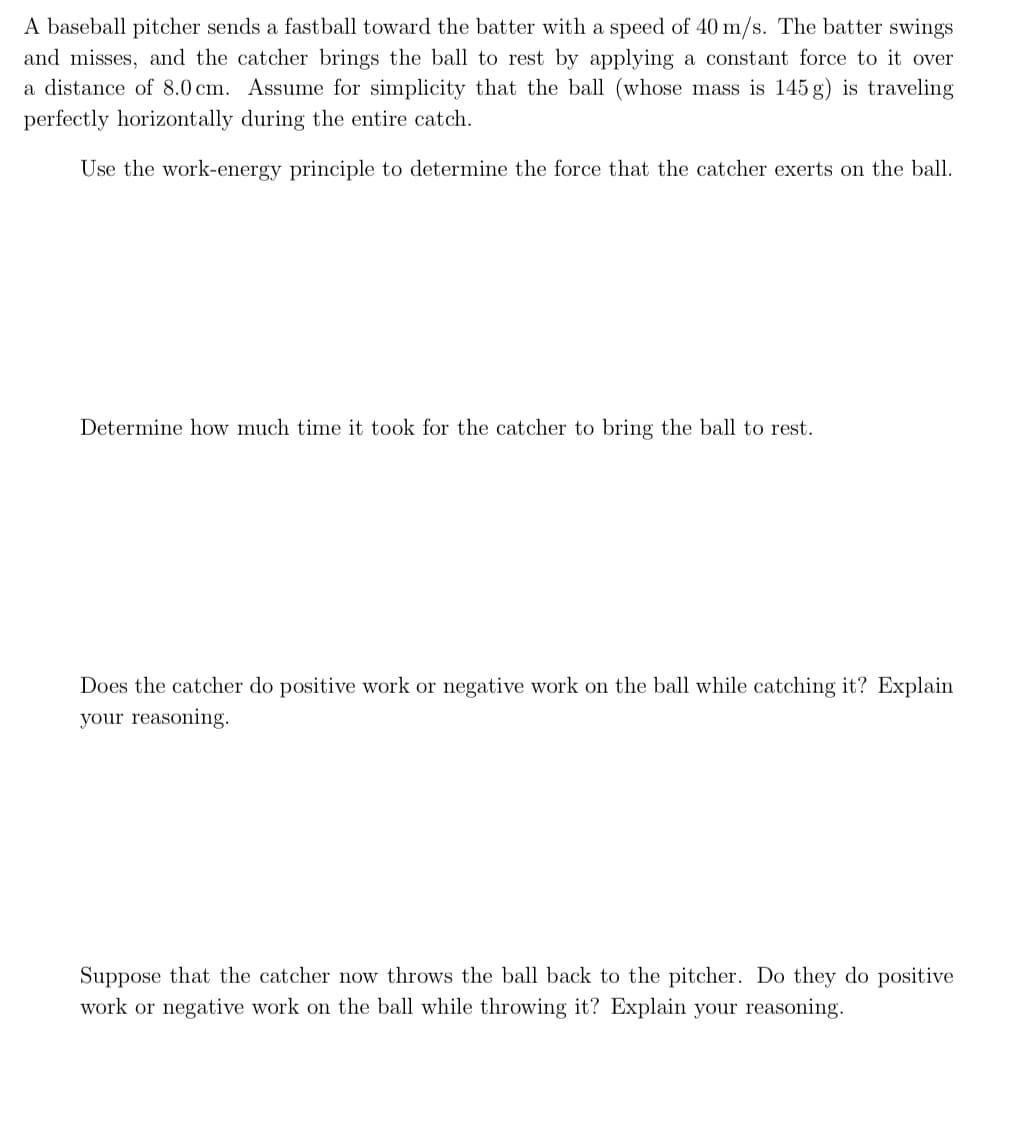A baseball pitcher sends a fastball toward the batter with a speed of 40 m/s. The batter swings and misses, and the catcher brings the ball to rest by applying a constant force to it over a distance of 8.0 cm. Assume for simplicity that the ball (whose mass is 145 g) is traveling perfectly horizontally during the entire catch. Use the work-energy principle to determine the force that the catcher exerts on the ball. Determine how much time it took for the catcher to bring the ball to rest. Does the catcher do positive work or negative work on the ball while catching it? Explain your reasoning. Suppose that the catcher now throws the ball back to the pitcher. Do they do positive work or negative work on the ball while throwing it? Explain your reasoning.
A baseball pitcher sends a fastball toward the batter with a speed of 40 m/s. The batter swings and misses, and the catcher brings the ball to rest by applying a constant force to it over a distance of 8.0 cm. Assume for simplicity that the ball (whose mass is 145 g) is traveling perfectly horizontally during the entire catch. Use the work-energy principle to determine the force that the catcher exerts on the ball. Determine how much time it took for the catcher to bring the ball to rest. Does the catcher do positive work or negative work on the ball while catching it? Explain your reasoning. Suppose that the catcher now throws the ball back to the pitcher. Do they do positive work or negative work on the ball while throwing it? Explain your reasoning.
Principles of Physics: A Calculus-Based Text
5th Edition
ISBN:9781133104261
Author:Raymond A. Serway, John W. Jewett
Publisher:Raymond A. Serway, John W. Jewett
Chapter7: Conservation Of Energy
Section: Chapter Questions
Problem 21P: A 5.00-kg block is set into motion up an inclined plane with an initial speed of i = 8.00 m/s (Fig....
Related questions
Topic Video
Question

Transcribed Image Text:A baseball pitcher sends a fastball toward the batter with a speed of 40 m/s. The batter swings
and misses, and the catcher brings the ball to rest by applying a constant force to it over
a distance of 8.0 cm. Assume for simplicity that the ball (whose mass is 145 g) is traveling
perfectly horizontally during the entire catch.
Use the work-energy principle to determine the force that the catcher exerts on the ball.
Determine how much time it took for the catcher to bring the ball to rest.
Does the catcher do positive work or negative work on the ball while catching it? Explain
your reasoning.
Suppose that the catcher now throws the ball back to the pitcher. Do they do positive
work or negative work on the ball while throwing it? Explain your reasoning.
Expert Solution
This question has been solved!
Explore an expertly crafted, step-by-step solution for a thorough understanding of key concepts.
This is a popular solution!
Trending now
This is a popular solution!
Step by step
Solved in 6 steps

Knowledge Booster
Learn more about
Need a deep-dive on the concept behind this application? Look no further. Learn more about this topic, physics and related others by exploring similar questions and additional content below.Recommended textbooks for you

Principles of Physics: A Calculus-Based Text
Physics
ISBN:
9781133104261
Author:
Raymond A. Serway, John W. Jewett
Publisher:
Cengage Learning

University Physics Volume 1
Physics
ISBN:
9781938168277
Author:
William Moebs, Samuel J. Ling, Jeff Sanny
Publisher:
OpenStax - Rice University

College Physics
Physics
ISBN:
9781938168000
Author:
Paul Peter Urone, Roger Hinrichs
Publisher:
OpenStax College

Principles of Physics: A Calculus-Based Text
Physics
ISBN:
9781133104261
Author:
Raymond A. Serway, John W. Jewett
Publisher:
Cengage Learning

University Physics Volume 1
Physics
ISBN:
9781938168277
Author:
William Moebs, Samuel J. Ling, Jeff Sanny
Publisher:
OpenStax - Rice University

College Physics
Physics
ISBN:
9781938168000
Author:
Paul Peter Urone, Roger Hinrichs
Publisher:
OpenStax College

Physics for Scientists and Engineers, Technology …
Physics
ISBN:
9781305116399
Author:
Raymond A. Serway, John W. Jewett
Publisher:
Cengage Learning

College Physics
Physics
ISBN:
9781285737027
Author:
Raymond A. Serway, Chris Vuille
Publisher:
Cengage Learning

Physics for Scientists and Engineers: Foundations…
Physics
ISBN:
9781133939146
Author:
Katz, Debora M.
Publisher:
Cengage Learning